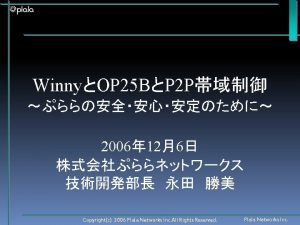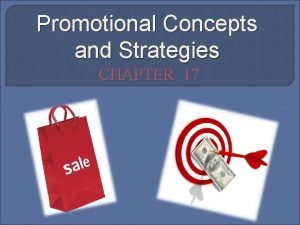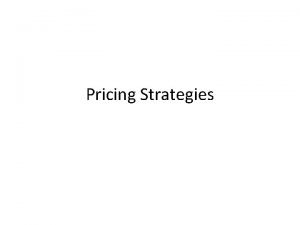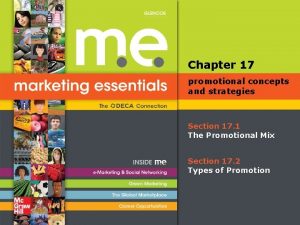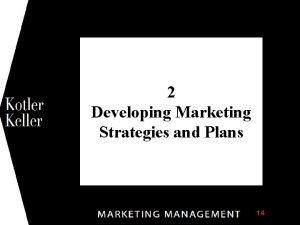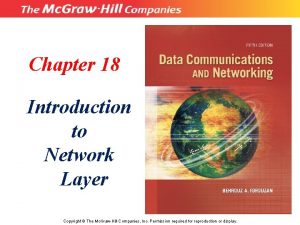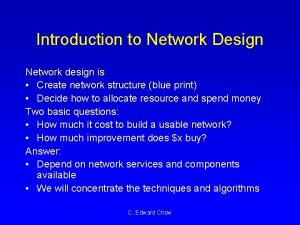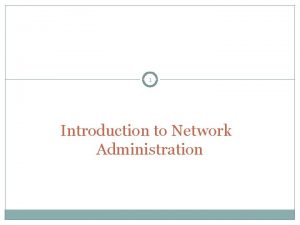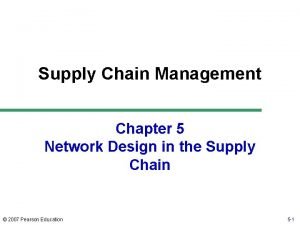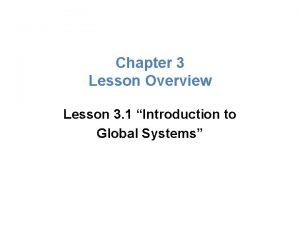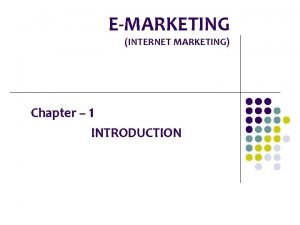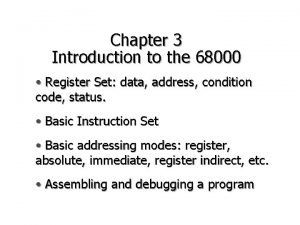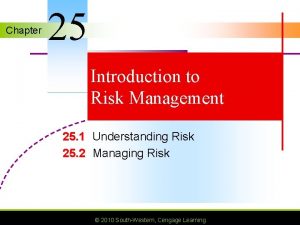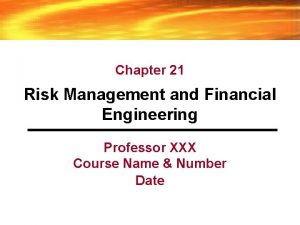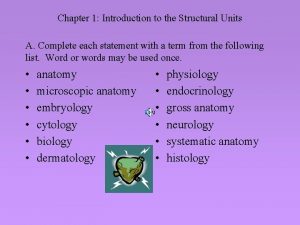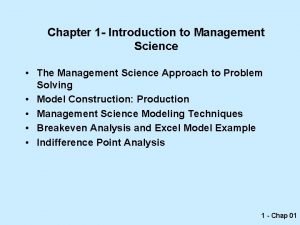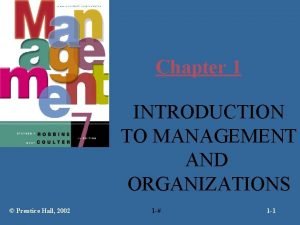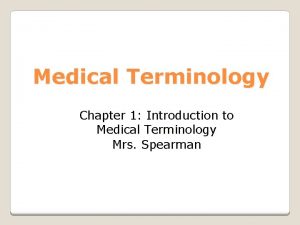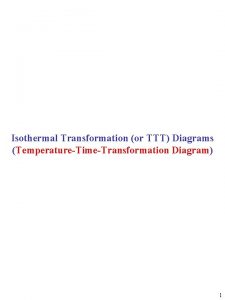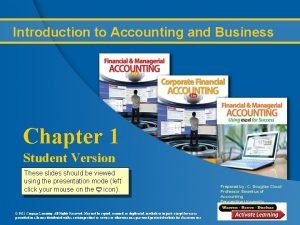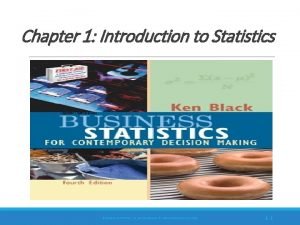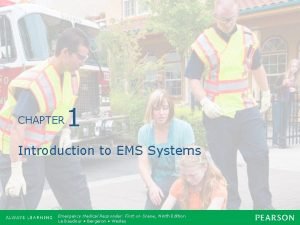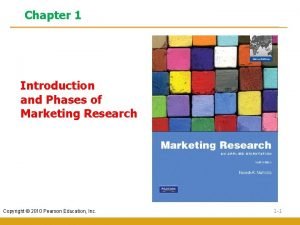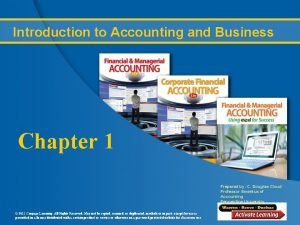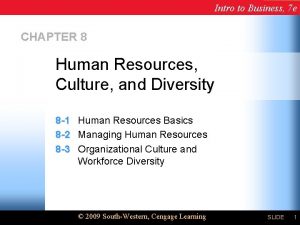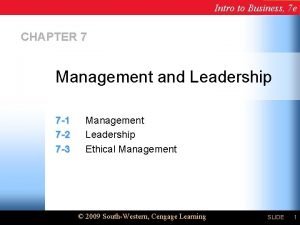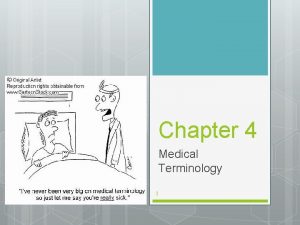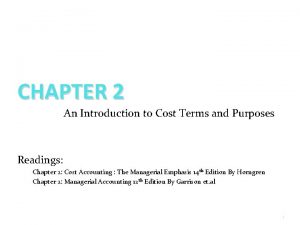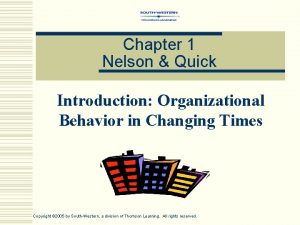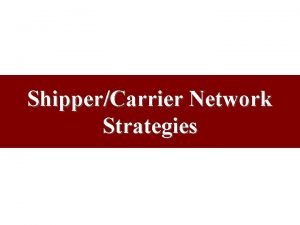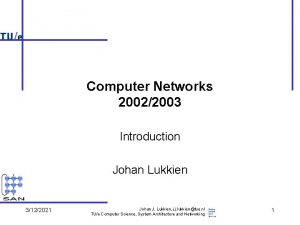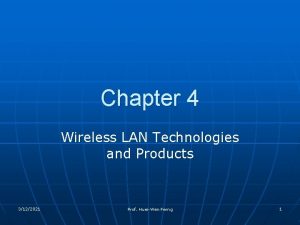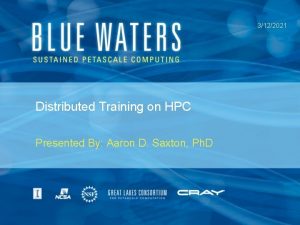Chapter 14 ShipperCarrier Network Strategies 3122021 1 Introduction


















































































- Slides: 82

Chapter 14 Shipper/Carrier Network Strategies 3/12/2021 1

Introduction Both shippers and carriers utilize strategies to manage their respective networks. The shipper strategy is focused on purchasing and managing transportation services to meet the needs of their external and internal customers. Carrier strategy is focused on the 3/12/2021 efficient use of resources to provide the 2

Shipper Transportation Strategy The transportation function is one element of the total logistics function. The strategies and operating decisions used in transportation management must support the strategies and objectives of the logistics function and those of the company. Current management strategy focuses on optimization between the various 3/12/2021 3

Shipper Transportation Strategy Transportation is often one of the largest cost elements, and decisions in this area can favorably or negatively impact the total distribution performance. For example, slow but low cost transportation can have an adverse impact on customer service and inventory levels. Although such methods may minimize transport cost, inventory levels may need to be much higher to accommodate longer transit times. These higher stocking levels, 3/12/2021 4 with the resultant increase in inventory carrying

Shipper Transportation Strategy Figure 14. 1(P. 435), transportation strategy is concerned with the purchase and control of transportation services. Transportation purchasing decisions include modal selection, consolidation, private trucking, intermediaries, and contracting. The resources, organization, and trade terms decisions are concerned with controlling 3/12/2021 5

General Strategy • Proactive management • Improve information • Limit Carriers used • Contracts for service • Negotiate • Review private trucking Small Shipments • Consolidate • Use drop-off carriers • Pooling services • Avoid private trucking Bulk Shipments • Contracts • Balanced loads for carrier • Partnership 3/12/2021 Strategic Decisions • Modal selection • Consolidation • Private trucking • Intermediaries • Trade terms • Contracting • Resources • Organization 6

Proactive Management The transportation manager relies on basic management techniques to seek innovative transportation systems that will provide the company with a competitive price or service advantage in the marketplace. Today the transportation manager must rely on his or her ability and creativity to design a transportation system that 3/12/2021 7

Proactive Management The current competitive environment requires that the transportation manager focus on customer service and competitive strategies. Successful logistics strategies are seen as a true competitive advantage, requiring transport support that can respond to ever increasing demands for smaller inventory levels combined with 8 3/12/2021

Improve Information To effectively manage the transportation function, reliable and current information is a necessity. Without information, the manager in unable to plan and control the transportation activities on make sound decisions. Transportation costs, shipment volume, and carrier performance are the typical data collected. These data are essential to carrier negotiation, freight 3/12/2021 9

Improve Information A major source of transportation information is the bill of lading. The bill of lading indicates the customer or vendor, the shipment volume, origin and destination, date, and carrier. The carrier’s freight bill (invoice) provides similar data as well as the transportation cost for the shipment. Other sources include the purchase order, order entry system, invoice, and internal studies. Some companies use a third-party provider, such as a bank or freight payment company, to pay freight bills, and most of 3/12/2021 10 these freight payment firms have the

Carrier Negotiation Negotiating with for-hire carriers is standard operating procedure today. Market power determines the shipper’s ability to negotiate acceptable rates and services. To increase market power, shippers use the strategy of limiting the number of carriers, thereby concentrating more of its economic power with a carrier and increasing the 11 3/12/2021

Carrier Negotiation A shipper’s market power and negotiating strength also are determined by the characteristics of its freight. Freight that has low density, is hard to handle, is easily damaged, and moves in small volumes irregularly is undesirable freight for the carrier. Conversely, products that have high density and high value, are difficult to damage, and move in large volumes 12 3/12/2021

Contracting The contracts allow the shipper to realize the lower rates and necessary service levels that are not attainable from a regulated carrier. During the term of the contract, the shipper is guaranteed the contracted rate and service. If properly written, the provisions of the contract take precedence over the bill of lading and transportation regulations. The transportation manager must take precautions to ensure that the contract 3/12/2021 13 provides desired terms such as rates,

Small Shipment Strategy The strategic thrust for small shipments is to reduce the inherently high transportation costs associated with small-sized shipments. By increasing the size of the shipments, the shipper can take advantage of the carrier’s low rates for heavier shipments. Rate discounts from 30 percent to 50 percent or more are possible for heavier 14 3/12/2021

Small Shipment Strategy A shipper consolidates its freight by using its order entry system. As customer orders arrive, a computer uses a three-digit zip code to match shipments going to the same general area. As discussed above, the need for information is critical to any freight consolidation program. The 3/12/2021 15

Small Shipment Strategy If the consolidated load consists of many shipments going to different consignees in a general area, the shipper may use the pooling service offered by for-hire carriers. The pooling service charges the shipper the lower volume rate from one origin to one destination. Because the consolidated load contains shipments for many consignees at different destinations, a warehouse or drayage firm is used to separate and deliver 3/12/2021 16 the individual shipment, and an added cost is

Small Shipment Strategy Another small shipment strategy is the use of stopping-in-transit (SIT) service provided by motor carriers. SIT permits the shipper to load a number of shipments on a vehicle and stop along the way to unload the individual shipments. Conversely, SIT can be used for inbound shipments by having the carrier stop along the way to load additional 17 3/12/2021 shipments and deliver a consolidated

Bulk Shipment Strategy The primary strategy used in the transportation of bulk commodities is contracting. Most bulk raw materials are moved under long-term contracts with rail, water, and motor carriers. The large volume of product moved gives the shipper the requisite negotiating and market power to realize lower rates and guaranteed service 3/12/2021 18

Bulk Shipment Strategy The sheer volume of transportation involved has caused both shippers and carriers to realize their mutual dependency. If the carrier ceases operation, the shipper experiences serious disruptions in service, higher costs, and possibly a short-run closing of production because alternative transportation is not available. Likewise, the carrier is aware of the 3/12/2021 19 large percentage of its business that is

Bulk Shipment Strategy Given this mutual dependency, a shipper attempts to provide the carrier with a balanced load, that is, a load into the facility and one out of the facility. A balanced load eliminates the empty backhaul costs that the carrier must account for in the initial loaded move and enables the carrier to spread this round-trip cost over two commodity 3/12/2021 20

Bulk Shipment Strategy To accomplish the balanced load strategy, cooperation is required between outbound and inbound (purchasing) transportation and may necessitate resourcing material purchases from areas where the carrier experiences empty backhauls. Recently, a major manufacturer contacted other shippers in an attempt to generate freight for its contract carrier to haul over an otherwise empty backhaul. This can be 3/12/2021 21 difficult if the commodity being transported

Traffic Management Traffic management is the traditional term for the task of obtaining and controlling transportation services for shippers or consignees or both. In many firms, traffic management is the core of business logistics department. Transportation in the firm exists in close trade-off relationships with purchasing, warehousing, inventory control, 3/12/2021 22

Traffic Management as a Procurement Function Traffic management is a special form of procurement and purchasing. Procurement is a term that applies to a wide range of activities that basically consists of obtaining goods and services for the firm. Procurement includes analysis and activities in the following areas: (See next page) 3/12/2021 All of these factors provide the firm with 23

Traffic Management as a Procurement Function 1. 2. 3. 4. 5. 6. 3/12/2021 Quality Pricing Specifications Supply source Negotiations Inspection and assurance of quality 7. Timing 8. Conducting value analysis of alternative methods and sources 9. Capital analysis 10. Make or buy decisions 11. Legal and regulatory constraints 24 12. General

Line and Staff Functions Originally, traffic management was a clerical activity devoted to shipping or receiving the firm’s goods. Today it entails a range of line functions that often are specialized and require communications and data systems. Traffic managers must observe field trends, evaluate potential procedural and system changes, plan for the implementation of appropriate changes, 25 3/12/2021

Carrier Selection Process The traffic manager’s decisions have a direct impact upon the company’s total logistics costs and quality of service provided to the customer. The transport selection decision is a two -part decision. The initial decision involves the selection of the mode and the second division relates to the selection of the specific carrier within 26 3/12/2021

Carrier Selection Process That is, the traffic manager examines the cost and service characteristics of the different modes, including the combination of two or more modes, and selects the mode that matches the company’s cost and service goals. Next, the traffic manager examines the cost and service characteristics of the individual carriers within the selected 27 3/12/2021

Carrier Selection Process The relevant carrier selection factors include transport cost, transit time reliability, accessibility, capability, and security. These factors impact the total logistics costs of movement and storage and are used in both the selection of the mode and specific carrier. 3/12/2021 28

Transport Cost The transport cost factor includes the rate charged by the potential carrier. In addition, this factor examines the charges assessed by the carrier for ancillary services such as residential delivery, controlled-temperature vehicles, and stops in transit. The transport cost varies from mode to mode because of the different cost structures of the modes, whereas the cost variation among carriers within a 29 3/12/2021 mode is less because the carriers have

Transit Time and Transit Time Reliability The total-cost implication of the carrier selection decision considers not only the direct transportation cost incurred but also the indirect costs associated with the quality of the service provided. Transit time and reliability of transit time are two transport service qualities that affect inventory costs and stockout costs. 3/12/2021 30

Transit Time and Transit Time Reliability Transit time impacts the level of inventory held and the consequent inventory carrying costs. The longer the transit time, the higher the inventory levels and the higher the inventory carrying costs. Therefore, the total cost impact of using a carrier (mode) with a longer transit time is higher inventory carrying costs. 31 3/12/2021

Transit Time and Transit Time Reliability Likewise, the reliability of transit time affects the level of inventory required. Unreliable transit time requires an increase in the level of inventory to guard against stockout conditions and the resultant cost of lost profit or lost productivity associated with not having the product available to meet the demand. Viewed from a marketing perspective, reliable transit time affords the buyer the opportunity to reduce or control both inventory and stockout 3/12/2021 32 costs. Thus, using a carrier that provides reliable

Accessibility The accessibility factor considers the ability of the carrier to provide the transport service between a specific origin and destination. The modes differ in their ability to provide direct service to specific locations. Physical limitations associated with roadways and terminals prohibit certain modes from providing direct services to a specific site. To overcome the accessibility of a mode, the services of another more accessible mode must be purchased. The addition expense to 3/12/2021 33 surmount a mode’s inability to service a

Capability The capability factor refers to the ability of the carrier (mode) to provide the unique transport services and equipment required by the user. The traffic manager will use the carrier that has the ability to provide the unique services or equipment required. Controlled-temperature vehicles for the movement of frozen foods High cube capacity vehicles for the movement of low-density products(plastic bottles, for 34 3/12/2021 example)

Security Considers the indirect transport service cost if the shipment is damaged or lost in transit. A damaged shipment has the same impact on inventory costs and stockout costs as unreliable transit time. A product damaged or lost in transit is not available for use when demanded and the user incurs the cost of processing a damage claim or legal action against the carrier to secure reimbursement, incurs the loss if reimbursement is not received from the carrier, 3/12/2021 35 or pays for insurance to provide protection

Line Aspects of Traffic management Although the management of individual traffic officers may vary, the typical traffic management process is as follows: 3/12/2021 Shipment planning Carrier selection Ordering service Expediting/tracing Preauditing/rating Auditing/paying the freight bill Detection/demurrage processes Claims, if nay Other – private car or truck fleet management, transportation budget management 36

Shipment Planning Traffic management continually monitors inbound and outbound shipping schedules, which should be coordinated with purchasing and distribution or production. A continuous flow of product should be maintained, unhindered by the unavailability of transportation (no equipment or service). Further, physical loading and unloading must be planned according to the efficient use of docks and labor. 3/12/2021 Management must ensure that transportation is 37 not

Carrier Selection In rail contexts this might be largely confined to the carrier that has a siding into the plant. But even here, the traffic manager may have some latitude in route selection through use of intermediate or alternative route carriers. In connection with motor carriers, traffic managers often will give shipment preference to the firm’s own private carriage vehicles or use a contract 3/12/2021 38

Ordering Service Electronic methods are becoming more common and the use of the Internet is accelerating this trend. In other cases, long-term arrangements for equipment supply include trailer pools and scheduled rotation. The traffic manager needs to inform the carrier personnel of the shipper’s name and pickup point, weight, commodity, destination, and sometimes the cube measurement of the shipment. Upon vehicle arrival, the equipment is loaded 3/12/2021 according to plans established in the first step 39

Expediting/Tracing The traffic manager keeps track of shipment progress and alerts the carrier of any en-route changes that might be necessary. Some shippers have direct computer links with carrier shipment systems. These provide daily position reports of all the shipper’s railcars or shipments. 3/12/2021 Some carriers provide Other carriers place information in a secure Web site that only particular shipper can access. This information is updated on a scheduled basis. Expediting/tracing is a valuable control tool for the shipper and consignee because they can plan production and assembly 40 around shipment progress

Preauditing/Rating Preauditing is the process of determining what the proper freight charges for a shipment should be. Often shippers pre-audit shipments before billing by the carrier so that freight bill overcharges and undercharges can be reduced or avoided. 3/12/2021 Computer rating systems have greatly 41

Auditing/Paying the Freight Bill Auditing entails checking the accuracy of the freight bill after it is presented by the carrier or after it has been paid. Some firms do this inhouse, whereas others hire outside consultants to perform 3/12/2021 this job after the bill Contract rates and services, the diminished importance of rate bureaus and their complex tariffs, and the growth of computers enable preauditing and postauditing to take place with fewer resources than in the past. Many carriers offer their rates often computer 42 floppy disks or will update

Detention/Demurrage Processes Detention is a charge assessed by a motor carrier against a shipper or consignee for keeping equipment for loading or unloading beyond a specified period. Demurrage is the 3/12/2021 same concept in the The traffic manager is usually responsible for monitoring, managing, and paying for detention and demurrage obligations. The manager must trade off the loading, unloading, and 43 personnel costs

Claims Loss and damage sometimes occur to shipments while in the possession of carriers. Traffic managers will then file claims to recoup part or all of these damaged amounts. They also handle overcharges on the freight bills. 3/12/2021 44

Claims Exceptions: – An act of God, an unavoidable catastrophe – An act of a public enemy, armed aggression against our country – An act of public authority, through due process of law, a government agency causes damage, loss, or delay – An act of the shipper, actions by the shipper contribute to the damage, such as improper 3/12/2021 45 packaging

Private Car and Truck Fleet Management In some firms, the traffic manager is also responsible for private railcar and truck fleet management. This entails coordination and control tasks with the goal of minimizing fleet costs and providing quality service. 3/12/2021 46

Transportation Budget Management The transportation budget is the major overriding financial control in all these tasks. The traffic manager must keep track of current and future activities and expenditures and relate them to the original plan. Cost escalators, such as fuel and insurance, have crated major problems for most traffic managers who attempt to operate within planned budgets. 3/12/2021 47 Escalation will no doubt continue to be a

Staff and Administrative Aspects of Traffic Management Traffic management has grown over the years to become more than a mere line activity. Many planning tasks or staff activities have developed as support functions. These other activities increase the cost efficiency or customer service capability of the line activities. 3/12/2021 48

Mode Selection The traffic manager selects the mode for specific classes of shipments or products, market areas, or each plant or warehouse. Each mode offers specific inherent service and cost advantages. Usually, the selection is made infrequently so that routing and carrier selection personnel can operate within 3/12/2021 49 the modal choice.

Monitoring Service Quality If the traffic manager can get the products to the customer in a timely, consistent, and undamaged basis, the buyer’s inventory and stockout costs are lowered, making it advantageous for the buyer to do business with the seller. The key to monitoring transportation service quality is information. The traffic manager must have information regarding the customer’s demands for transportation 3/12/2021 50 service and the service level provided by

Monitoring Service Quality The carrier evaluatino report is used to assure that carriers are providing the service quality that is demanded by the customers or specified by agreement. Carriers not providing the expected level of service are asked to take corrective actions or the traffic manager will replace the carrier. Typically, the most important evaluation criteria are meeting pickup and delivery 3/12/2021 51 schedules and transit time.

Service/Supply Assurance During the late 1990 s, strikes in the trucking industry caused several periods of carrier supply disruption. As a reaction to those events, many firms have prepared for such future occurrences by planning for alternative and backup forms of transportation. 3/12/2021 52

Negotiations require a large degree of preparation, analysis, and proper approach and conduct. A negotiation that attains a rate that the carrier eventually finds unremunerative(無報 酬的) and incapable of serving effectively is to be avoided. In this instance, both the shipper and carrier lose. Rail and motor contract services are increasing in use, and many negotiations take 3/12/2021 place for specific services, rather than lower 53

Planning Annual Transportation Requirements Another staff-related task is interpreting the firm’s purchasing, production, and marketing plans for future periods and translating the plans into specific shipping needs. This list represents the specific type of equipment needed and the quantities and timing of its use. Automobile manufacturers often must work with railroads several years in advance so that railcars exist when new automobile 3/12/2021 54 models of specific sizes and shapes roll of

Budgeting Traffic managers play the key role in establishing transportation budgets for future periods. The budget usually integrates volumes, expected modal mixes, specific shipping patterns, and expected inflationary impacts. Capital budgets are prepared for analyzing the technical and financial feasibility of proposed major asset acquisitions such as private fleets, railcars, new docks, expanded rail sidings, 3/12/2021 55 computer systems, or warehouse and dock

Information Systems The astute traffic manager will always seek ways to attain and report information relating to the carrier’s services and individual manager performance. Many firms monitor and report cost and transit time performance for all movements, including the private fleet. They also may record cost recoveries and claims progress. In all, performance reevaluation and 3/12/2021 56 decision-making information systems are a

Systems Analysis There is no one best way of always transporting a firm’s goods. Where motor might be a proper choice in normal periods, air freight might be necessary occasionally. What is a good choice one day might be poor one the next. Within traffic management, continuous analyses must be conducted to put together the best service and total cost configuration. Traffic management must be integrated within the overall materials management and 3/12/2021 57 distribution scheme of the firm.

Management and Executive Development Traffic and transportation are changing at a fast pace in a manner not experienced in the past. It is imperative that all personnel keep track of changes in the field, analyze them, and provide for positive action by the firm. They also must update their personal technical knowledge and management skills by reading about all aspects of transportation and management, keeping in contact with others through professional associations, taking advantage of educational opportunities, 3/12/2021 58 and keeping a perspective on how a present

Traffic Department Human Resources Management Another major area of managerial analysis with which traffic managers are concerned is the use of human resources within the department. Traffic managers often must determine whether human resource hours will return more for the firm if allocated to auditing freight bills or to analyzing new transportation processes. 3/12/2021 59

Carrier Strategies Transportation is a service, not a production activity. Except for pure pleasure cruise travel and some auto travel, transportation faces a derived demand not a primary demand for its services. Further, transportation is a service that cannot be stored; it is unlike a physical product that can be produced according to certain logistical efficiencies and then 3/12/2021 60 held until the market demands it.

Operations The rule of efficiency states that it is most efficient to move in a continuous, straight line whenever possible. This rule describes the most efficient movement for goods and people. It calls for little or no circuitry and minimized stopping and restarting. Sporadic movement means energy loss, chances for delay and damage, and an overall 61 3/12/2021 increase in costs.

Operations This general rule can be observed in practice in many areas. – Unit trains such as coal or grain avoid intermediate classification yards between the shipper and receiver. – Truck firms attempt to consolidate long-haul loads so that a single through run, with no intermediate handling, is made and the goods can be sorted for final local delivery at the ultimate destination. – The airline industry strives to maximize long-haul nonstop flights because major fuel and engine-wear costs are incurred in take-offs. – Further, the costs of maintaining a transportation 62 3/12/2021 vehicle in constant motion are small in relation to the

Operations The full capacity of the transportation vehicle should be maximized on each run. Transportation costs of trucks, trains, ships, and planes are similar in that the costs of personnel, depreciation, licenses, and taxes are relatively fixed costs that are incurred for each run. The variable amount of goods or people in the run will affect fuel costs, some servicing costs, and loading and unloading costs. 3/12/2021 63

Operations Most transportation managers seek to fill the capacity of the vehicle before dispatching it. In the railroad and trucking industries, managers often will delay runs so that more freight can be accumulated for the long haul. The driver or engine crew is paid the same regardless of the weight in the truck or the cars on the train. Airline marketing and pricing managers use low-cost excursion fares to entice vacationers to fill what normally would be empty seats. 64 3/12/2021

Operations Consolidation and break-bulk activities should be used for long-haul advantages. One means of attaining full equipment use is to use a pickup and delivery network to accumulate freight for the line-haul efficiency. Trucking firms do this with city vehicles that bring different shipments to a terminal for sorting, accumulation, and shipping in bulk to the destination city terminal. 3/12/2021 65

Operations This system avoids the prohibitive use of many small trucks and shipments by using large, efficient single units on 400 to 500 mile runs. Railroads perform this task in much the same way. Many airlines have adopted hub-andspoke route strategies around such cities as Atlanta, Denver, St. Louis, Pittsburgh, and Chicago. Here smaller planes bring passengers from less populated, outlying cities to the hub where the 3/12/2021 66 larger, more efficient planes can be used for the

Operations Empty mileage should be minimized. The cost of moving an empty vehicle is almost that of moving a loaded one without the offset of revenue. Energy is a major cost in transportation systems. In very few instances can a firm afford one-way loaded movements with empty return hauls. Each mile traveled requires the use of energy, and often the payload in freight or passengers 3/12/2021 67 represents only a small part of the total

Operations That is, the movement of the vehicle itself can often be responsible for a large part of the fuel consumed. For this reason, transportation route strategies, carrier marketing and pricing personnel, and dispatchers strive to arrange two-way or threeway moves with almost all miles bearing revenue payloads. Empty miles represent wasted fuel, labor, capital costs, and lost revenue. Motor carriers 68 3/12/2021 strive to maintain empty miles at 10 percent or

Operations Movements should be scheduled and dispatched so as to fully use labor and equipment in line with the market. Transportation service cannot be stored. Because the service must be in place for the market, this rule calls for the optimal equipment levels to be in place with the required personnel. Neither the equipment nor the required labor should delay the move. In some rail and trucking firms, power units accumulate at one 69 3/12/2021 end of the system while there is a need for

Operations Likewise, a waste occurs when crews arrive for work and there is no equipment available for the trip or little freight to be handled that day. Some motor carrier firms avoid this problem through the use of on-line shipment record systems that indicate to terminal managers how much freight will be arriving inbound during future shift periods. Thus, crews of optimal size can then be 3/12/2021 70 called for particular shifts of work.

Technology and Equipment The more expensive the long-haul vehicle, the greater the required investment in fast load/unload and other support equipment. Because these expensive investments are only earning revenue when they are running, firms strive to operate with a minimum of down time or loading and unloading time. Generally, the larger the vehicle, or the more freight or passengers that can be moved in it, the less each unit will cost to move. 3/12/2021 71

Technology and Equipment With most transportation vehicles, the larger they are, the lower the ton-mile or seat-mile cost will be – for several reasons. – One reason is that the manufacturing cost of most forms of propulsion engines makes larger horsepower or thrust engines cost per horsepower less than smaller units. – A second reason is that larger planes, trains, trucks, and so on carry more payload without a proportionate increase in crew requirements. Simply illustrated, both a 10 -72 3/12/2021 passenger van and a 60 -passenger bus are

Technology and Equipment The fastest possible speed is not always the most efficient for economical operations. In the water carrier industry, this is often expressed as follows: As the speed of a vehicle doubles, the fuel consumption and horsepower requirements are squared. On the other hand, even with very low speeds, fuel consumption can be costly. For every form of vehicle (including planes and ships), a rough J curve represents fuel consumption in which the most fuel-efficient 3/12/2021 73 speeds are somewhat less than the vehicle’s

Technology and Equipment Vehicle weight should be minimized in relation to gross weight. Transportation propulsion equipment as well as wings, hulls, rails, and highway pavements and bridges are designed for certain fixed gross weights (weight of the vehicle and the payload in freight or passengers). Therefore, the less the vehicle itself weights, the more it can carry in the form of freight or passengers. This is the reason why lighter metals and plastics are designed for use in motor-carrier 3/12/2021 74 tractors and in aircraft.

Technology and Equipment should be standardized as much as possible. Standardized equipment simplifies planning, purchasing, crew training, maintenance, and spare parts inventories. When equipment is standardized among firms, efficient equipment interchange can take place. 3/12/2021 75

Technology and Equipment should be adapted to special market and commodity requirements. Many shipping firms require specialized equipment for the economical movement of particular commodities. During the 1960 s, grain shippers desired the larger, more economical covered hopper cars in place of the traditional small boxcar. Airlines use the smaller DC-9 to serve shorter -distance, smaller cities; B-727 s are used in longer-range markets; and jumbo planes are 3/12/2021 76 used in transcontinental long hauls.

Technology and Equipment The transportation industry is also characterized by extremely sophisticated communications technology. Nearly all truckload carriers such as Schneider National and J. B. Hunt have installed satellite technology and computers on their tractors to be able to communicate in real time with drivers. 77 3/12/2021

The Hub-and-Spoke Route System The hub-and-spoke system concentrates the flow of passengers and freight along a fewer number of routes with a main mixing point (hub) at a center. All flights or runs meet at this hub where passengers or freight can be switched to runs to any other point in the system. It expands the number of points the carrier can offer travelers with good schedules , and it concentrates more business into a fewer number of runs. The motor-carrier industry employs this structure using break-bulk terminals that consolidate freight 3/12/2021 78 to faraway points with a minimum of intermediate

Marketing Transportation firms are faced with the challenge of developing and marketing something that cannot be felt, inventoried, or tested. This makes the marketing of carrier services extremely important to the profitability of the firm, and a knowledge of marketing concepts is critical to this success. 3/12/2021 79

Marketing Service marketing is different from product marketing because of the differences between products and services. – First, services are intangible. The inability to see, feel, and try a service before it is produced makes it more difficult to sell and more difficult for buyers to make purchase decisions. – Second, there is a focus on the service provider. For example, the satisfaction an airline traveler feels toward a flight can be greatly influenced by the service provided by cabin attendants and ticket agents. 3/12/2021 Likewise, truck drivers who make customer deliveries 80

Marketing – Third, service providers are usually highly laborintensive. This can make service quality subject to more variability. – Fourth, there is a simultaneous production and consumption of services; that is, there is no inventory. Transportation services cannot be produced before demand occurs to take advantage of production economies. Equipment, in the form of capacity, can be put into place in anticipation of demand, but production of transportation service occurs at the same time as demand. – Finally, services are perishable. A move by rail has no 3/12/2021 81 shelf life. Likewise, empty seats on an airplane are lost

Coordination 3/12/2021 82
 3122021
3122021 3122021
3122021 3122021
3122021 3122021
3122021 Introduction paragraph strategies
Introduction paragraph strategies Introduction to algorithmic trading strategies
Introduction to algorithmic trading strategies Introduction to algorithmic trading strategies
Introduction to algorithmic trading strategies Introduction to algorithmic trading strategies
Introduction to algorithmic trading strategies Zip trading algorithm
Zip trading algorithm Virtual circuit and datagram
Virtual circuit and datagram Network topologies
Network topologies Features of peer to peer network and client server network
Features of peer to peer network and client server network Network systems design using network processors
Network systems design using network processors Network centric computing and network centric content
Network centric computing and network centric content Difference between circuit switching and packet switching
Difference between circuit switching and packet switching Chapter 17 promotional concepts and strategies answer key
Chapter 17 promotional concepts and strategies answer key Chapter 26 pricing strategies answer key
Chapter 26 pricing strategies answer key 5 generic business strategies
5 generic business strategies The central instrument for directing and coordinating
The central instrument for directing and coordinating Types of promotion
Types of promotion Price adaptation strategies
Price adaptation strategies Chapter 26 pricing strategies
Chapter 26 pricing strategies Tailing hedge
Tailing hedge Chapter 2 developing marketing strategies and plans
Chapter 2 developing marketing strategies and plans Introduction to network security and cryptography
Introduction to network security and cryptography Introduction to network layer
Introduction to network layer Public switched telephone network notes
Public switched telephone network notes Introduction to network design
Introduction to network design Introduction to network administration
Introduction to network administration Introduction to cryptography and network security
Introduction to cryptography and network security Introduction to cryptography and network security
Introduction to cryptography and network security Body paragraph
Body paragraph Network design in the supply chain chapter 5
Network design in the supply chain chapter 5 Chapter 3 network protocols and communications
Chapter 3 network protocols and communications Levels of ecological organization
Levels of ecological organization Function of operation manager
Function of operation manager Introduction to management science chapter 5 solutions
Introduction to management science chapter 5 solutions Chapter 52: an introduction to ecology and the biosphere
Chapter 52: an introduction to ecology and the biosphere Introduction of e-marketing
Introduction of e-marketing Stoichiometry introduction
Stoichiometry introduction Chapter 9 introduction to waves
Chapter 9 introduction to waves Chaparral climograph
Chaparral climograph Chapter 3 parts of research
Chapter 3 parts of research Motorola 68000 instruction set
Motorola 68000 instruction set Pure risk examples
Pure risk examples Chapter 24 section 1 animal characteristics
Chapter 24 section 1 animal characteristics Chapter 21 introduction to risk management
Chapter 21 introduction to risk management Chapter 19 protists worksheet answers
Chapter 19 protists worksheet answers Introduction to the structural units chapter 1 answers
Introduction to the structural units chapter 1 answers Medical terminology learning exercises chapter 1
Medical terminology learning exercises chapter 1 Introduction to management science chapter 1 solutions
Introduction to management science chapter 1 solutions Introduction to management chapter 1
Introduction to management chapter 1 New approaches to organizing hr
New approaches to organizing hr Human resources management chapter 1
Human resources management chapter 1 Waistline
Waistline Introduction to corporate finance what companies do
Introduction to corporate finance what companies do Introduction to business accounting
Introduction to business accounting Managers and management chapter 1
Managers and management chapter 1 Contrasting prefixes medical terminology
Contrasting prefixes medical terminology Inversion hotline
Inversion hotline Introduction to psychology chapter 1
Introduction to psychology chapter 1 Probability of a and b
Probability of a and b Introduction to materials science for engineers chapter 10
Introduction to materials science for engineers chapter 10 Introduction to accounting and business chapter 1
Introduction to accounting and business chapter 1 Who was mc lerry
Who was mc lerry Chapter 1 introduction to chemistry
Chapter 1 introduction to chemistry Chapter 8: an introduction to metabolism
Chapter 8: an introduction to metabolism Chapter 1 introduction to statistics
Chapter 1 introduction to statistics Introduction to ems systems chapter 1
Introduction to ems systems chapter 1 Introduction to marketing research chapter 1
Introduction to marketing research chapter 1 Foundations in personal finance answers chapter 1
Foundations in personal finance answers chapter 1 Introduction to chemistry chapter 1
Introduction to chemistry chapter 1 Flow of food servsafe
Flow of food servsafe Introduction to accounting and business chapter 1
Introduction to accounting and business chapter 1 Introduction to business chapter 8
Introduction to business chapter 8 Intro to business chapter 7 study guide
Intro to business chapter 7 study guide Chapter 8 an introduction to metabolism
Chapter 8 an introduction to metabolism Cardi meaning medical
Cardi meaning medical An introduction to cost terms and purposes
An introduction to cost terms and purposes The study of life section 1 introduction to biology
The study of life section 1 introduction to biology Organizational behavior chapter 1
Organizational behavior chapter 1 Introduction to welding chapter 1
Introduction to welding chapter 1 Chapter 1 introduction to statistics
Chapter 1 introduction to statistics



